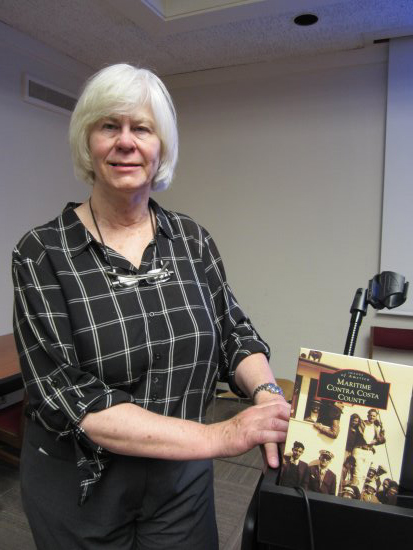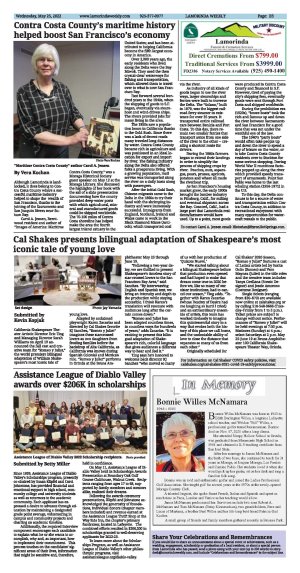| | Published May 25th, 2022
| Contra Costa County's maritime history helped boost San Francisco's economy
| | | By Vera Kochan |  | | "Maritime Contra Costa County" author Carol A. Jensen Photo Vera Kochan |
Although Lamorinda is landlocked, it does belong to Contra Costa County where a successful maritime industry helped to shape the wealth of San Francisco, thanks to the joining of the Sacramento and San Joaquin Rivers near Suisun Bay.
 Carol A. Jensen, Brentwood resident and author of "Images of America: Maritime Contra Costa County," was a Moraga Historical Society guest speaker on May 12 at the Moraga Library. She discussed the highlights of her book with the aid of a slide presentation documenting how the county provided deep-water ports with which agricultural, mineral and manufactured goods could be shipped worldwide. The 70-100 miles of Contra Costa shoreline has helped make the area the fourth largest inland estuary in the United States; and has been attributed to helping California become the fifth largest economy in America.
Carol A. Jensen, Brentwood resident and author of "Images of America: Maritime Contra Costa County," was a Moraga Historical Society guest speaker on May 12 at the Moraga Library. She discussed the highlights of her book with the aid of a slide presentation documenting how the county provided deep-water ports with which agricultural, mineral and manufactured goods could be shipped worldwide. The 70-100 miles of Contra Costa shoreline has helped make the area the fourth largest inland estuary in the United States; and has been attributed to helping California become the fifth largest economy in America.
 Over 2,000 years ago, the early residents who lived along the Delta were the Bay Miwok. They used the then crystal-clear waterways for fishing and transportation, which allowed them to travel over to what is now San Francisco Bay.
Over 2,000 years ago, the early residents who lived along the Delta were the Bay Miwok. They used the then crystal-clear waterways for fishing and transportation, which allowed them to travel over to what is now San Francisco Bay.
 Fast forward several hundred years to the 1840s, when the shipping of goods to S.F. began, eventually via steamboat and wind-driven ships. The rivers provided jobs for many living in the area.
Fast forward several hundred years to the 1840s, when the shipping of goods to S.F. began, eventually via steamboat and wind-driven ships. The rivers provided jobs for many living in the area.
 The 1850s saw a population boom in California thanks to the Gold Rush. Since there was a lack of decent roads many traveled long distances by water. Contra Costa County became rich in agriculture and was positioned in an ideal location for export and import by river. The fishing industry along the Delta also offered folks a prosperous living. With a growing population, mail service was transported along the river on a daily basis along with passengers.
The 1850s saw a population boom in California thanks to the Gold Rush. Since there was a lack of decent roads many traveled long distances by water. Contra Costa County became rich in agriculture and was positioned in an ideal location for export and import by river. The fishing industry along the Delta also offered folks a prosperous living. With a growing population, mail service was transported along the river on a daily basis along with passengers.
 After the initial Gold Rush, Chinese migrants came to the Delta in the 1860s to try their hand with the shrimping industry and were immensely successful. Immigrants from England, Scotland, Ireland and Wales came to work in the Black Diamond Mines (Antioch), which transported coal via the river.
After the initial Gold Rush, Chinese migrants came to the Delta in the 1860s to try their hand with the shrimping industry and were immensely successful. Immigrants from England, Scotland, Ireland and Wales came to work in the Black Diamond Mines (Antioch), which transported coal via the river.
 As industry of all kinds of goods began to use the river ways, larger steamships and ferries were built to traverse the Delta. The "Solano," built in 1879, was the biggest railroad ferry steamer in existence for over 35 years. It transported entire railroad cars between Benicia and Port Costa. To this day, there remain two smaller ferries that transport autos from one side of the river to the other -- creating a shortcut route for drivers.
As industry of all kinds of goods began to use the river ways, larger steamships and ferries were built to traverse the Delta. The "Solano," built in 1879, was the biggest railroad ferry steamer in existence for over 35 years. It transported entire railroad cars between Benicia and Port Costa. To this day, there remain two smaller ferries that transport autos from one side of the river to the other -- creating a shortcut route for drivers.
 During the 1880s farmers began to extend their landings in order to simplify the process of shipping crops by river.? Peaches, nuts, asparagus, pears, prunes, apricots, potatoes and wheat all made the riverboat trip.
During the 1880s farmers began to extend their landings in order to simplify the process of shipping crops by river.? Peaches, nuts, asparagus, pears, prunes, apricots, potatoes and wheat all made the riverboat trip.
 As San Francisco's housing market grew, the early 1900s brought the lumber industry to Pittsburg, Calif., for milling and eventual shipment across the Bay. Concord, Calif., had a large port that Lamorinda residents/farmers would have used. Up to a point, most goods were produced in Contra Costa County and financed in S.F.? However, tired of paying the city's shipping fees, eventually goods were sent through Port Costa and shipped worldwide.
As San Francisco's housing market grew, the early 1900s brought the lumber industry to Pittsburg, Calif., for milling and eventual shipment across the Bay. Concord, Calif., had a large port that Lamorinda residents/farmers would have used. Up to a point, most goods were produced in Contra Costa County and financed in S.F.? However, tired of paying the city's shipping fees, eventually goods were sent through Port Costa and shipped worldwide.
 During the prohibition era (1920s), "booze boats" took the rich and famous up and down the river between Sacramento and San Francisco for a good time that was not under the watchful eye of the law.
During the prohibition era (1920s), "booze boats" took the rich and famous up and down the river between Sacramento and San Francisco for a good time that was not under the watchful eye of the law.
 The 1940's "party boats" would often take people up and down the river to spend a day of leisure on the water, or to take Contra Costa County residents over to Stockton for some serious shopping. During World War II munitions factories popped up along the river which provided speedy transport of armaments. Point San Pablo was home to the last whaling station (1956-1971) in the U.S.
The 1940's "party boats" would often take people up and down the river to spend a day of leisure on the water, or to take Contra Costa County residents over to Stockton for some serious shopping. During World War II munitions factories popped up along the river which provided speedy transport of armaments. Point San Pablo was home to the last whaling station (1956-1971) in the U.S.
 To this day, the Delta continues to be a source of water and transportation within Contra Costa County, in addition to recreational enjoyment with many opportunities for watercraft rentals to the public.
To this day, the Delta continues to be a source of water and transportation within Contra Costa County, in addition to recreational enjoyment with many opportunities for watercraft rentals to the public.
 To contact Carol A. Jensen email: Historian@ByronHotSprings.com.
To contact Carol A. Jensen email: Historian@ByronHotSprings.com. |
| | | | | | | | | | | | |



